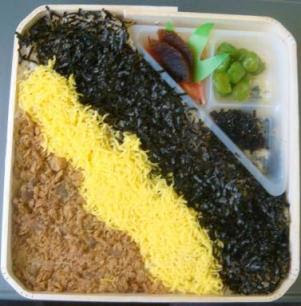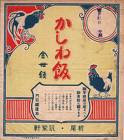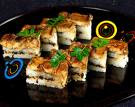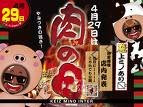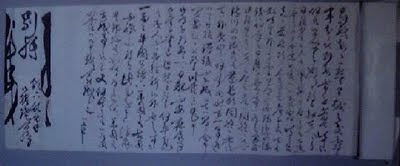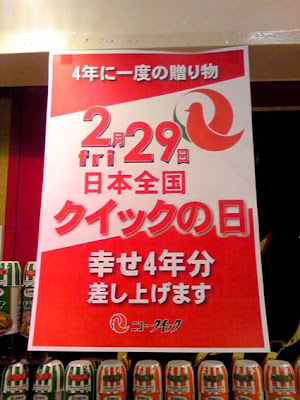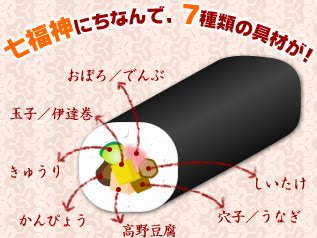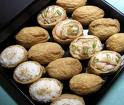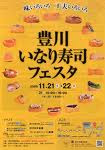[ . BACK to WORLDKIGO TOP . ]
::::::::::::::::::::::::::::::::::::::::::::::::::::::::::::::::::::::::::::::::::::::::::::::::::::
corbicula from Seta (Seta shijimi)
***** Location: Japan
***** Season: All Spring
***** Category: Animal
*****************************
Explanation
Seta shijimi 瀬田蜆(せたしじみ / セタシジミ)
corbicula from Seta
. . . CLICK here for Photos !
Shijimi 蜆 (しじみ) corbicula
Corbicula japonica
:::::::::::::::::::::::::::::::::::::::::::::::::::::::::::::::::::::::::::::::::::::::::::::::::::
Shijimi was very popular during the Edo period. Children would get them and sell them in the early morning hours for the shijimi miso soup and thus make a little pocket money.
:::::::::::::::::::::::::::::::::::::::::::::::::::::::::::::::::::::::::::::::::::::::::::::::::::

Matsuo Basho, Seta poems and the Big Bridge at Seta
Seta no Oohashi 瀬田の大橋 at the Lake Biwako
. Matsuo Basho 松尾芭蕉 - Archives of the WKD .
五月雨に隠れぬものや瀬田の橋
samidare ni kakurenu mono ya Seta no hashi
in the endless rain of June
this one is not hidden -
the great bridge of Seta
samidare ... during the rainy season, now in June.
There is a stone with this haiku in Otsu.
大津市瀬田唐橋公園
One of the eight sights of Omi. Seta is the only river that flows out of the lake Biwa. The bridge structure is influenced by Chinese architecture. It was also used in the performance of the bamboo Tamasudare
Nanjing Tamasudare たますだれ (玉簾/珠簾)
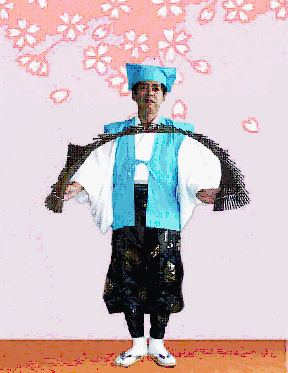
Seta no Karahashi 近江八景の一つ、瀬田の唐橋
. . . CLICK here for Photos of woodblock prints!
..........................................................................
橋桁の忍は月の名残り哉
hashigeta no shinobu wa tsuki no nagori kana
most probably also about the Bridge of Seta
. Matsuo Basho 松尾芭蕉 - Archives of the WKD .
:::::::::::::::::::::::::::::::::::::::::::::::::::::::::::::::::::::::::::::::::::::::::::::::::::
There is also a wafer filled with sweet bean paste of the same form, inpressed with
SETA.
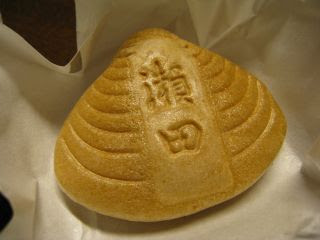
和菓子司 角安本舗
大津市瀬田2-3-11
*****************************
Worldwide use
*****************************
Things found on the way
WASHOKU
Shiga Prefecture - Regional Dishes from Omi and Seta
*****************************
HAIKU
Fireflies from Seta
目に残る吉野を瀬田の蛍哉
me ni nokoru yoshino o seta no hotaru kana
held in my eye:
with Yoshino's blooms
Seta's fireflies
Matsuo Basho
Basho recalls spring blossoms at Yoshino as he sees summer's fireflies at Seta.
Tr. and comment : Barnhill
"my eyes recall Yoshino's sakura in Seta's fireflies"
held in my eye:
with Yoshino's blooms
Seta's fireflies
source : Dennis Kawaharada
still before my eyes
cherry blossoms of Yoshino
fireflies of Seta
Tr. Reichhold
It seems to me that Basho must have seen a LOT of fireflies at Seta to make such a comparison: a 'cloud' of fireflies as it were, to match the 'clouds' of cherry blossoms.
Interestingly, Blyth does not translate this haiku, perhaps because he obviously couldn't translate everything, but also perhaps because Blyth felt it didn't fit his criteria for what makes a good haiku.
I, however, like haiku about places, or that mention places. For one thing, the reference to or mere mention of a place automatically makes a haiku 'larger'.
Since the mere mention of "Yoshino" in Basho's haiku suggests "cherry blossoms," he didn't have to say "sakura" in the haiku. But he did have to mention fireflies in relation to Seta, so I'm assuming that there is no tradition in Japanese poetry linking "fireflies" and "Seta."
But Seta, in the mid-1600s, was well-known for its fireflies, especially on the Seta River (and Lake Biwa too?) I have read online that
"When the light show was at its peak in early summer, hotaru-bune boats would take people on eating and drinking excursions to the best places to see them."
This would make firefly-viewing in some ways similar to cherry-blossom viewing.
So although 'fireflies of Seta' may not have been an 'utamakura' (poetic place), perhaps Basho was trying to make it one? Or at least he was making it into a 'haimakura' (haikai place).
. Compiled by Larry Bole

hotarubune 蛍船 ship for viewing fireflies
蛍見や船頭酔うておぼつかな
hotarumi ya sendoo yoote obotsukana
watching fireflies -
the boatsman is drunk
and we worry
Matsuo Basho in 1690
Basho was in Omi and enjoyed the fireflies around lake Biwa. Boats were located near the Bridge and people could drink sake while watching the fireflies. It was most enjoyable to see the fireflies reflected in the water.
Even the boatsman was drunk and the boat must have shaken quite a bit. This haiku reflects the happy mood when watching fireflies.
闇の夜や子供泣き出す蛍舟
yami no yo ya kodomo nakidasu hotarubune
pitchdark night -
the children start crying
on the firefly boat
Boncho 凡兆 (in Sarumino)
While the grown-ups enjoy a drink and make merry, the kids are full of fear in the dark.
.................................................................................
Compiled by Larry Bole, Translating Haiku Forum
A couple of more translations:
hotarumi ya sentoo yoote obotsukana (Basho)
Firefly viewing at Seta
firefly viewing--
the boatman is drunk,
the boat unsteady
Tr. Barnhill
Firefly viewing--
The steersman is drunk
And how unsteady the boat!
Tr. Ueda
firefly viewing
when the boatman is drunk
unsteady
Tr. Reichhold
Viewing fireflies and
the pilot is drunk
how unsettling...
Tr. Liza Dalby,
from her book, "east wind melts the ice: a memoir through the seasons," U. of California Press, 2007 (she is best-known for her book, "Geisha")
And here is Dalby's translation of Boncho's haiku:
yami no yo ya kodomo nakidasu hotarubune
A dark night
crying children
on a firefly boat
Dalby's comment on both haiku:
Neither Basho nor Boncho seems to have been entirely at ease with the raucous scene of drunken adults and crying children on this excursion. At the same time, their poems avoid the stereotypical fireflies-over-the-water-isn't-it-lovely sentimentality of the usual firefly haiku. Two hundred years later, novelist Natsume Soseki (1867-1916) wrote a more typical nostalgic haiku recalling a scene from his boyhood as he and his older sister hurried home over dark mountain paths on a summer night:
katamaru ya chiru ya hotaru no kawa no ue
Clumping and
scattering, fireflies
over the river
--Natsume Soseki (1897)
Tr. Dalby
Now gathering,
Now scattering,
Fireflies over the river.
Tr. Sooiku Shigematsu
Dalby goes on to discuss the tradition of children catching fireflies.
I find it particularly interesting when Dalby writes about the commercial aspect of firefly 'consumerism':
Even long-urbanized Tokyo was still threaded with streams and rivers until the nineteenth century. One didn't have to travel far to find a damp source for fireflies. In fact, one didn't need to travel at all, because vendors would sell you bulk fireflies to light up your garden.
In the 1920s,
Moriyama City in Shiga Prefecture alone supported four large firefly wholesalers who, together, sold three million wild insects to city folk every June and July. The Moriyama suppliers prided themselves on their 'genji-botaru', "Genji fireflies"---at three-quarters of an inch by far the largest of Japan's firefly species.
Both Japanese and American firefly populations began dwindling in the mid-twentieth century due to pollution and loss of habitat. In 1951, the Japanese began to study firefly breeding requirements in order to build artificial hatcheries. Fireflies are still sold today, but they are now farmed. The state of the environment has been at the forefront of Japanese political concerns for several decades now, and as a result wild fireflies have made a resurgence in many of their old habitats. The tourist bureaus of several prefectures will happily supply a list of favorite places for firefly viewing.
[end of comment]
And there is an interesting anecdote about another almost-by-Boncho firefly haiku, in "Kyorai's Conversations with Basho," translated by Donald Keene (excerpted in Robert Hass's "The Essential Haiku"):
田の畝の豆つたひ行螢かな
ta no heri no mame tsutai yuku hotaru kana
Along the border of the fields
Following the bean plants
Go the fireflies.
Banko 伊賀万乎(まんこ)Iga Manko
[Tr. Donald Keene]
Kyorai writes:
This verse was originally one by Boncho that the Master [Basho] had corrected. When we were compiling 'The Monkey's Cloak', Boncho remarked, "This verse has nothing special to recommend it. Let's leave it out." Kyorai answered, "The lights of the fireflies following the bean plants at the edge of a field splendidly evoke a dark night."
But Boncho was not convinced by these words. The Master said, "If Boncho throws it away, I'll pick it up. It fortunately happens that one of the Iga poets has a similar verse that I can modify into this one." Thus, it finally appeared as Banko's poem.
[end of excerpt]
Hass's note:
Iga was Basho's home district, and he took a special interest in its poets.
[end of note]
. . . . .
. WKD : Fireflies (hotaru)
. sendoo sendō 船頭 boatsman, ferryman, chief fisherman .
.......................................................................
. yuku toshi no Seta o mawaru ya kane hikyaku .
Yosa Buson and the Hikyaku fast money messengers
::::::::::::::::::::::::::::::::::::::::::::::::::::::::::::::::::::::::::::::::::::::::::::::::::::
 source : blog.livedoor.jp/nara_suimeishi
宮戸川 Miyatogawa
source : blog.livedoor.jp/nara_suimeishi
宮戸川 Miyatogawa
歌川国芳 Utagawa Kuniyoshi - 名酒揃 (1846) (1846)
Miyatogawa was part of the river Sumidagawa, and also famous for fishing Edo mae unagi 江戸前うなぎ eel.
The lady in the print has blackened teeth, so she was not yet married. She was probably a servant at a Sake shop and maybe on her way home with a catch of local 業平しじみ Narahira Shijimi.
*****************************
Related words
*****
Introducing Japanese Haiku Poets
*****
WASHOKU : FISH and SEAFOOD SAIJIKI
:::::::::::::::::::::::::::::::::::::::::::::::::::::::::::::::::::::::::::::::::::::::::::::::::::::::::::::::::::::::::::
[ . BACK to DARUMA MUSEUM TOP . ]
[ . BACK to WORLDKIGO . TOP . ]
:::::::::::::::::::::::::::::::::::::::::::::::::::::::::::::::::::::::::::::::::::::::::::::::::::::::::::::::::::::::::::
